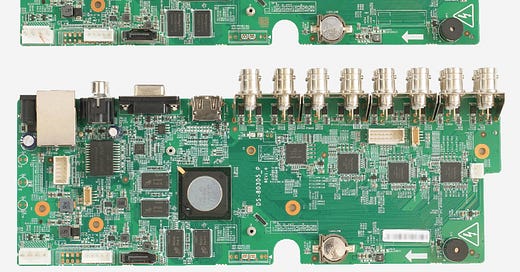Greetings from a world where…
Planet Word is out of this world
…As always, the searchable archive of all past issues is here. Please please subscribe here to support ChinAI under a Guardian/Wikipedia-style tipping model (everyone gets the same content but those who can pay support access for all AND compensation for awesome ChinAI contributors).
Feature Translation: “Taiwan Skin, Mainland Bones” in a Made-in-Taiwan Surveillance System
Context: In December 2020, the Taiwan government ordered that certain products purchased by government agencies could be sourced from Chinese brands, including technology from Hikvision, China’s largest surveillance company. Last September, CommonWealth Magazine, one of Taiwan’s most influential business media, looked underneath the hood of digital video recorders (DVR) that had received the “Made in Taiwan” seal of approval. They discovered a phenomenon of “Taiwan Skin, Mainland Bones”: surveillance equipment sold by Taiwanese brands that were essentially the same as Hikvision products (link to original Chinese).
Key Takeaways: The CommonWealth Magazine team uncovered 9 key pieces of evidence
The motherboard design for both the “Made in Taiwan” product of Taiwanese company Benelink (top image) is a replica of the design for a Hikvision product
CommonWealth reporters and software engineers also investigated the software interface of these products. The user interface, API set-up, and digital certificates all linked the Benelink product back to Hikvision technology.
From the article: “A senior security control engineer, who assisted CommonWealth in the dismantling, said, ‘From the appearance, it can be judged that this is a product and model from the same company and the same source.’ ”
Hikvision persists in Taiwan as an original equipment manufacturer (OEM), which makes products sold by another company
This “Taiwan Skin, Mainland Bones” trend extends to intersection monitoring systems in Hsinchu Industrial Park (Taiwan’s Silicon Valley). Benelink won the bid to provide surveillance equipment, and one of the products used is the digital video recorder dismantled by Commonwealth.
These types of bans are hard to enforce. How can you prevent this OEM channel? In the article, Jian Hongwei, director of the Information Security Department of the Taiwanese government’s executive branch, stated, “Strictly speaking, (we) can't control it.” We saw this with the U.S. provisions that prohibited government agencies from purchasing Chinese cameras and surveillance equipment.
One final note: Interestingly, we see a similar (almost converse) phenomenon in China’s semiconductor manufacturing companies. In the past, industry circles would describe most Chinese companies in this field as "made up of Mainland skin and Taiwan bones” [陆皮台骨]. For more, see this Caixin article.
For more details on how CommonWealth conducted their investigation (some really cool reporting and photographs), see FULL TRANSLATION: China’s Sky Eye Becomes a Taiwanese Quality Good – Dismantling the MIT Surveillance System to Tear Open the Truth of “Taiwan Skin, Mainland Bones”
ChinAI Links (Four to Forward)
Should-read: Lessons From the World’s Two Experiments in AI Governance
In this Carnegie Endowment for International Peace commentary, Matt O’Shaughnessy and Matt Sheehan compare the EU and China’s approaches to AI governance, using the lens of “horizontal” (covering many AI applications) vs. “vertical” (application-specific regulations). A lot of good nuggets, including re: the algorithm registry: “created by the recommendation algorithm regulation and reaffirmed by the deep synthesis regulation, both of which require developers to register their algorithms. It acts as a central database for Chinese officials to gather information on algorithms”
Should-read: More Reporting on ChatGPT in China
This past week, I provided more commentary on hurdles to China’s development of large language models.
Meaghan Tobin and Lyric Li, in The Washington Post, highlight the importance of OpenAI’s InstructGPT work in bridging GPT-3 and ChatGPT — we haven’t seen anything similar by Chinese labs. This is one of the few news articles I’ve seen that actually cites papers published by Baidu on their Ernie models.
Karen Hao and Shen Lu, in The Wall Street Journal, detail some additional barriers to Chinese large language models, including access to high-end chips such as Nvidia A100s, which are the most efficient for training such models.
Should-read: China’s Challenges and Capabilities in Human Capital for General-Purpose Technologies
Last Friday, I testified in front of the U.S.-China Economic and Security Review Commission on the subject: “China’s Challenges and Capabilities in Human Capital for General-Purpose Technologies.” The link includes video of the hearing as well as my written testimony.
Should-read: Despite ban, Chinese surveillance equipment infiltrating Taiwan in plain sight
Elaine Huang, for CommonWealth Magazine’s English portal, provides more details on their investigation into how Chinese vendors Hikvision and Dahua have entered the Taiwanese market disguised as Taiwanese brands. Includes a section on Taiwan’s domestic security equipment sector.
Thank you for reading and engaging.
These are Jeff Ding's (sometimes) weekly translations of Chinese-language musings on AI and related topics. Jeff is an Assistant Professor of Political Science at George Washington University.
Check out the archive of all past issues here & please subscribe here to support ChinAI under a Guardian/Wikipedia-style tipping model (everyone gets the same content but those who can pay for a subscription will support access for all).
Any suggestions or feedback? Let me know at chinainewsletter@gmail.com or on Twitter at @jjding99




This is an interesting Substack for China tech (albeit I hate the layout format you are using as its hard for me to read or rather skim your article titles!😀). I will add a link to the front page of http://www.emergingmarketskeptic.com/ (I have not paid for a security certificate yet so ignore any browser warning) under Substacks. Have you looked at some of the research work Momentum Works https://momentum.asia/ in Singapore has done in the China-SE Asia tech space?